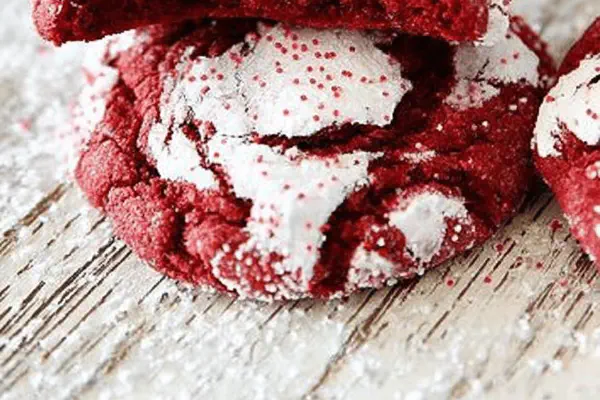Red Velvet White Chip Cookies

By Emma
Certified Culinary Professional
Ingredients
- 1 box red velvet cake mix (14 oz), replaced cornstarch with 3 tbsp arrowroot powder
- 1/2 tsp fine sea salt
- 1/2 cup unsalted butter, softened
- 3/4 cup granulated sugar
- 2 large eggs
- 1 tsp vanilla extract
- 1 tbsp brewed espresso (optional twist)
- 1 cup white chocolate chunks (sub white chocolate chips)
- Optional: pinch baking soda to balance acidity
About the ingredients
Method
- Mix cake mix, arrowroot powder, salt (and baking soda if using) in a large bowl. The arrowroot helps with chew and structure where cornstarch would.
- Use paddle attachment on stand mixer, cream butter and sugar medium speed until pale and fluffy. About 3 minutes. Don’t skimp here — texture depends on aeration.
- Add eggs one at a time, mixing briefly between. Stir in vanilla extract and espresso if you want richer notes. Use rubber spatula to scrape sides periodically to stop dry pockets.
- Gradually fold in dry ingredients. Don’t rush. The dough is sticky — that’s normal. Overmixing ruins tenderness but under-mixing leaves clumps.
- Fold white chocolate chunks gently — tired of chocolate chips? Chunks melt better but watch for clumps that can cause collapsing cookies.
- Cover dough with plastic wrap. Chill at least 45 minutes for firmness and ease of scooping. Longer chill = thicker cookies.
- Preheat oven to 380°F. Reason: slightly hotter than usual for crisper edges without overbaking middles.
- Line two baking trays with parchment or silicone mats. Keeps bottoms even browned, no sticking, less clean-up.
- Scoop out cookies with 2 tbsp measure roughly, placing 6 per sheet, spaced apart so they don’t run. My experience: crowding equals flat, greasy mess.
- Bake 9-13 minutes. Look for edges turning slightly darker red, centers puffed but not browned. Remove when edges look set but middles still soft-looking. Cookies firm as they cool.
- Leave cookies on sheet 20 minutes minimum before moving to wire racks to complete cooling. Critical for texture setting. Don’t rush or they break.
- Store any extra dough chill tight, up to 3 days, or freeze up to 3 months. Thaw overnight in fridge before using.
Cooking tips
Chef's notes
- 💡 Don’t rush mixing dry and wet. Fold gently; sticky dough tells you when done. Overmixing tightens gluten—tough cookies after. Arrowroot used here swaps cornstarch moisture; adds chew but watch dough texture closely while folding. Use rubber spatula scraping often — dry pockets kill consistency.
- 💡 Cream butter, sugar to light, pale fluff only. Creamer means air trapped — affects final chew. About 3 minutes medium speed stand mixer. Skimp here? Dense, flat cookies. Eggs add one at a time; breaks form if dumped in all at once. Scrape sides; keep batter uniform. Espresso not just flavor — little bitterness balances sweet chunks.
- 💡 Chill dough minimum 45 mins. Sticky dough tries sticking to scoop, hands. Chilling firms butter, easier handling. Longer chill? Thicker cookies hold shape better in oven. Skip chill and expect spreading mess. Parchment or silicone mats prevent bottoms burning; oven hotspots hit these trays.
- 💡 Oven hotter than usual at 380°F. Crisp edges signal done, not minutes. Look for darker red edges and puffed, soft centers just before pulling out. Cookies settle firm when cooling — if removed too soon they crumble. Wait 20 mins on tray before transferring to wire rack to finish cooling; rushed transfers risk breakage.
- 💡 White chocolate chunks beat chips — melt spots uneven but chunk retention better; chunks don’t break down during folding, unlike chips that melt fast when overmixed. Fold chunks last, slow, with patience to avoid breaking them up. Try substituting chips but expect less distinct melt patterns.
Common questions
Why use arrowroot instead cornstarch?
Arrowroot holds moisture better. Less thickening though. Adds chew texture not in cornstarch. Not common but worth experiment on chew. Watch dough stickiness; arrowroot needs careful hydration.
Is espresso necessary?
Optional. Adds depth, slight bitterness. Helps balance sugar. If no espresso, vanilla alone works. Coffee powder or instant coffee crushed fine can replace. Skip if kids involved taste-wise; flavor subtle anyway.
Sticky dough difficult to handle?
Chill dough solidifies butter — key to easier scoop and shaping. If dough too sticky after chill, dust hands lightly with flour or chill longer. Don’t add too much flour, changes bake. Cold dough also controls spread.
How to store leftover dough?
Wrap tight air-free in plastic. Fridge max 3 days. Freeze longer up to 3 months in portioned balls. Thaw overnight in fridge before baking—warm dough spreads more. Label if freeze long, avoids soggy smells or freezer burn.



